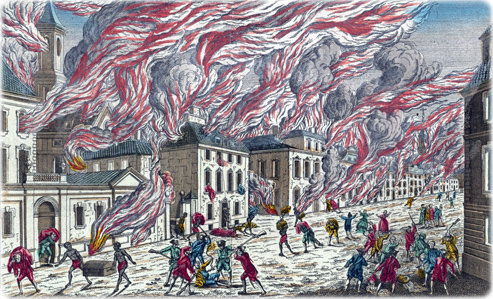
The Great Fire of New York in 1776
The Great Fire of New York City in the 18th century occurred on September 21, 1776, less than a week after the British occupied the city during the Independence War. It started about 1 a.m. on the eastern side of Broadway, near Whitehall Slip. The Fire spread and raged with violence. Many blamed British soldiers. Other suggested it was one or more people that deliberately started the fire. Dry weather and strong winds fanned the fire, that was not under control before nearly 11 a.m.
The west side of the city was devastated and the flames, which had crossed Broadway, consumed the lower part of the city in a northwesterly direction, between Whitehall Slip and Barkley Street. The fire pushed across the houses lining Cortlandt, Dey, and Vesey streets. Among the buildings destroyed were the Trinity Church, first temple, and the Lutheran Church. David Grim estimated that 493 houses were burned, others estimated a thousand or more. However, Richard Howe (Notes On The Great Fires Of 1776 And 1778, Gotham Center, 2014) estimated that "it would have been next to impossible to fit 1,000 houses into the burnt out area". Several people died, but most of the residents had left the City before the British invasion. Reconstruction was not immediate.
On the night of August 3, 1778, another great fire burned about 60 shops, houses and warehouses, most of them on Cruger’s Wharf and half of the adjacent block north of Water Street.
The British controlled the City until November, 1783. Two other great fires ravaged New York, in 1835 and in 1845.

Fictitious view of the Great Fire of New York in 1776, probably based on a European town. In the print, flames and smoke stream from a row of houses as chaos reigns in the streets. Armed soldiers beat civilians, while African slaves carry trunks of goods from some houses. Creator: André Basset. Source: Boston Public Library.
|
Copyright © Geographic Guide - Old NYC. 18th Century. |

The Great Fire of New York in 1776